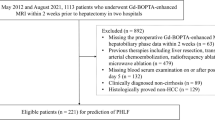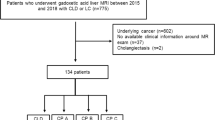Abstract
Objectives
To determine the value of gadobenate dimeglumine (Gd-BOPTA)–enhanced magnetic resonance imaging (MRI) from the hepatobiliary phase for predicting poor outcome in acute-on-chronic liver failure (ACLF) patients.
Methods
In this single-center retrospective study, 74 patients diagnosed as ACLF who underwent Gd-BOPTA-enhanced hepatobiliary magnetic resonance imaging were collected. The quantitative liver–spleen contrast ratio (Q-LSC) and the relative enhancement ratio of the biliary system (REB) at the hepatobiliary phase were measured. Cox proportional hazards regression models were used to evaluate prognostic factors. The capacity of the Q-LSC and REB to predict the 90-day outcome was evaluated via receiver operating characteristic (ROC) curve.
Results
During the follow-up period, twenty-eight of 74 ACLF patients (38%) had a poor outcome. The Q-LSC and REB were significant predictive factors (hazard ratio [HR] = 0.03 [0.002–0.54], p < 0.05; HR = 0.07 [0.01–0.88], p < 0.05) for prognosis in patients with ACLF. Moreover, the areas under the ROC curves of Q-LSC and REB for predicting poor outcome in patients with ACLF were 0.81 and 0.80, respectively. The most appropriate cutoff values for the Q-LSC and REB were 1.09 and 0.57, respectively. The ACLF patients with the Q-LSC ≤ 1.09 or REB ≤ 0.57 had a low cumulative survival.
Conclusions
Gd-BOPTA-enhanced hepatobiliary phase MR imaging can predict poor outcome in patients with acute-on-chronic liver failure.
Key Points
• The quantitative liver–spleen contrast ratio at the hepatobiliary phase was a significant predictive prognostic factor in patients with acute-on-chronic liver failure.
• The relative enhancement ratio of the biliary system at the hepatobiliary phase was a significant prognostic factor in patients with acute-on-chronic liver failure.
• Gadobenate dimeglumine contrast-enhanced MR imaging from the hepatobiliary phase can predict poor outcome in patients with acute-on-chronic liver failure.






Similar content being viewed by others
Abbreviations
- ACLF:
-
Acute-on-chronic liver failure
- AUC:
-
Area under the curve
- CI:
-
Confidence interval
- CLIF–C OF:
-
CLIF Consortium organ failure score
- CLIF–C SOFA:
-
Chronic Liver Failure Consortium sequential organ failure assessment score
- Gd-BOPTA:
-
Gadobenate dimeglumine
- HR:
-
Hazard ratio
- HUI:
-
Hepatic uptake index
- ICC:
-
Intraclass correlation coefficient
- MELD:
-
Model for End-Stage Liver Disease
- MRI:
-
Magnetic resonance imaging
- OATP:
-
Organic anion transporting polypeptides
- Q-LSC:
-
The quantitative liver–spleen contrast ratio
- REB:
-
The relative enhancement ratio of the biliary system
- ROC:
-
Receiver operating characteristic
- ROI:
-
Region of interest
- SI:
-
Signal intensity
References
Sarin SK, Choudhury A, Sharma MK et al (2019) Acute-on-chronic liver failure: consensus recommendations of the Asian Pacific association for the study of the liver (APASL): An update. Hepatol Int 13:353–390
Mezzano G, Juanola A, Cardenas A et al (2021) Global burden of disease: acute-on-chronic liver failure, a systematic review and meta-analysis. Gut. https://doi.org/10.1136/gutjnl-2020-322161
Arroyo V, Moreau R, Kamath PS et al (2016) Acute-on-chronic liver failure in cirrhosis. Nat Rev Dis Primers 2:16041
Zhang J, Gao S, Duan Z, Hu KQ (2016) Overview on acute-on-chronic liver failure. Front Med 10:1–17
Gustot T, Jalan R (2019) Acute-on-chronic liver failure in patients with alcohol-related liver disease. J Hepatol 70:319–327
Chan AC, Fan ST, Lo CM et al (2009) Liver transplantation for acute-on-chronic liver failure. Hepatol Int 3:571–581
Wiesner R, Edwards E, Freeman R et al (2003) Model for end-stage liver disease (MELD) and allocation of donor livers. Gastroenterology 124:91–96
Hernaez R, Patel A, Jackson LK, Braun UK, Walling AM, Rosen HR (2020) Considerations for prognosis, goals of care, and specialty palliative care for hospitalized patients with acute-on-chronic liver failure. Hepatology 72:1109–1116
Gustot T, Fernandez J, Garcia E et al (2015) Clinical course of acute-on-chronic liver failure syndrome and effects on prognosis. Hepatology 62:243–252
Arroyo V, Moreau R (2017) Diagnosis and prognosis of acute on chronic liver failure (ACLF) in cirrhosis. J Hepatol 66:451–453
Wang X, Sarin SK, Ning Q (2015) Definition of ACLF and inclusion criteria for extra-hepatic organ failure. Hepatol Int 9:360–365
Sun Z, Liu X, Wu D et al (2019) Circulating proteomic panels for diagnosis and risk stratification of acute-on-chronic liver failure in patients with viral hepatitis B. Theranostics 9:1200–1214
Bastati N, Beer L, Mandorfer M et al (2020) Does the functional liver imaging score derived from gadoxetic acid-enhanced MRI predict outcomes in chronic liver disease? Radiology 294:98–107
Poetter-Lang S, Bastati N, Messner A et al (2020) Quantification of liver function using gadoxetic acid-enhanced MRI. Abdom Radiol (NY) 45:3532–3544
Tsuboyama T, Onishi H, Kim T et al (2010) Hepatocellular carcinoma: hepatocyte-selective enhancement at gadoxetic acid-enhanced MR imaging–correlation with expression of sinusoidal and canalicular transporters and bile accumulation. Radiology 255:824–833
Tanimoto A, Lee JM, Murakami T, Huppertz A, Kudo M, Grazioli L (2009) Consensus report of the 2nd International Forum for Liver MRI. Eur Radiol 19:S975–S989
Liu C, Sun Y, Yang Y et al (2021) Gadobenate dimeglumine-enhanced biliary imaging from the hepatobiliary phase can predict progression in patients with liver cirrhosis. Eur Radiol 31:5840–5850
Zhao X, Huang M, Zhu Q, Wang T, Liu Q (2015) The relationship between liver function and liver parenchymal contrast enhancement on Gd-BOPTA-enhanced MR imaging in the hepatocyte phase. Magn Reson Imaging 33:768–773
Sandrasegaran K, Cui E, Elkady R et al (2018) Can functional parameters from hepatobiliary phase of gadoxetate MRI predict clinical outcomes in patients with cirrhosis? Eur Radiol 28:4215–4224
Kudo M, Gotohda N, Sugimoto M et al (2018) Evaluation of liver function using gadolinium-ethoxybenzyl-diethylenetriamine pentaacetic acid enhanced magnetic resonance imaging based on a three-dimensional volumetric analysis system. Hepatol Int 12:368–376
Yamada A, Hara T, Li F et al (2011) Quantitative evaluation of liver function with use of gadoxetate disodium-enhanced MR imaging. Radiology 260:727–733
Wlodzimirow KA, Eslami S, Abu-Hanna A, Nieuwoudt M, Chamuleau RA (2013) A systematic review on prognostic indicators of acute on chronic liver failure and their predictive value for mortality. Liver Int 33:40–52
Hernaez R, Solà E, Moreau R, Ginès P (2017) Acute-on-chronic liver failure: an update. Gut 66:541–553
Planchamp C, Pastor CM, Balant L, Becker CD, Terrier F, Gex-Fabry M (2005) Quantification of Gd-BOPTA uptake and biliary excretion from dynamic magnetic resonance imaging in rat livers: model validation with 153Gd-BOPTA. Invest Radiol 40:705–714
Planchamp C, Gex-Fabry M, Becker CD, Pastor CM (2007) Model-based analysis of Gd-BOPTA-induced MR signal intensity changes in cirrhotic rat livers. Invest Radiol 42:513–521
Noda Y, Goshima S, Kajita K et al (2016) Biliary tract enhancement in gadoxetic acid-enhanced MRI correlates with liver function biomarkers. Eur J Radiol 85:2001–2007
Okada M, Ishii K, Numata K et al (2012) Can the biliary enhancement of Gd-EOB-DTPA predict the degree of liver function? Hepatobiliary Pancreat Dis Int 11:307–313
Schulz M, Trebicka J (2021) Acute-on-chronic liver failure: a global disease. Gut. https://doi.org/10.1136/gutjnl-2020-323973
Zhou XP, Lu T, Wei YG, Chen XZ (2007) Liver volume variation in patients with virus-induced cirrhosis: findings on MDCT. AJR Am J Roentgenol 189:W153-159
Xu Z, Ren X, Liu Y et al (2011) Association of hepatitis B virus mutations in basal core promoter and precore regions with severity of liver disease: an investigation of 793 Chinese patients with mild and severe chronic hepatitis B and acute-on-chronic liver failure. J Gastroenterol 46:391–400
Huang K, Hu JH, Wang HF et al (2011) Survival and prognostic factors in hepatitis B virus-related acute-on-chronic liver failure. World J Gastroenterol 17:3448–3452
Radha Krishna Y, Saraswat VA, Das K et al (2009) Clinical features and predictors of outcome in acute hepatitis A and hepatitis E virus hepatitis on cirrhosis. Liver Int 29:392–398
Funding
This work was supported in part by the Natural Science Foundation of Shandong Province (No. ZR2020MH285).
Author information
Authors and Affiliations
Corresponding authors
Ethics declarations
Guarantor
The scientific guarantor of this publication is Prof. Xinya Zhao.
Conflict of Interest
The authors of this manuscript declare no relationships with any companies whose products or services may be related to the subject matter of the article.
Statistics and Biometry
No complex statistical methods were necessary for this paper.
Informed Consent
Written informed consent was waived by the Institutional Review Board.
Ethical Approval
Institutional Review Board approval was obtained.
Methodology
• retrospective
• observational
• performed at one institution
Additional information
Publisher's Note
Springer Nature remains neutral with regard to jurisdictional claims in published maps and institutional affiliations.
Rights and permissions
About this article
Cite this article
Liu, C., Shen, Z., Ma, H. et al. Gd-BOPTA-enhanced hepatobiliary phase MR imaging can predict the prognosis of patients with acute-on-chronic liver failure. Eur Radiol 32, 3006–3015 (2022). https://doi.org/10.1007/s00330-021-08440-5
Received:
Revised:
Accepted:
Published:
Issue Date:
DOI: https://doi.org/10.1007/s00330-021-08440-5




